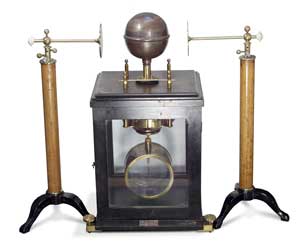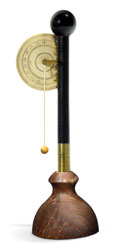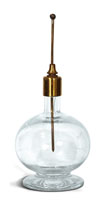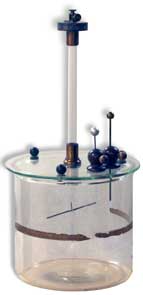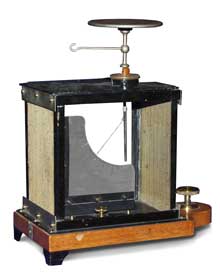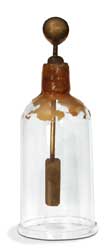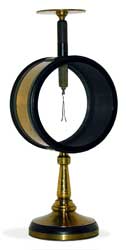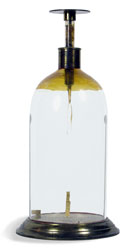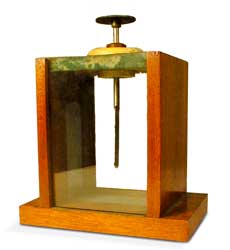|
|
|
|
|
|
The First Voltmeters
|
The term electroscope is given to instruments which serve two primary purposes: 1) to determine if a body is electrified, and 2) to determine the nature of the electrification. An electrometer, on the other hand, is a specialized form of electroscope that includes a calibrated scale for reading the strength of the charge.*
The first electroscope was a device called a versorium, developed in 1600 by William Gilbert (1544-1603), Physician to Queen Elisabeth I.. The versorium was simply a metal needle allowed to pivot freely on a pedestal. The metal would be attracted to charged bodies brought near. A simple hanging thread - called a "Pendulous thread" by Stephen Gray, (1666-1736) was introduced around 1731. The thread would be attracted to any electrified body nearby. In 1753 John Canton improved the electroscope by adding two small pith balls suspended by fine linen thread. The upper ends of the threads were fastened inside a wooden box. When placed in the presence of a charged body, the two balls would become similarly charged, and since like charges repel, the balls would separate. The degree of separation was a rough indicator of the amount of charge. In 1770, William Henley developed the first portable quadrant electrometer. The date is sometimes referenced as 1772 since that was the first time the invention was published (phil trans 1772, 63, p. 359.) The device consisted of an insulated stem with an ivory or brass quadrant scale attached. A light rod or straw extended from the center of the arc, terminating in a pith ball which hung touching the brass base of the electrometer. When the brass was electrified the ball would move away from the base, producing an angle which could be read off of the scale. See illustration, below left.
In 1779 Tiberius Cavallo (1749-1809) designed an improved electroscope, his "pocket electrometer" (see figure 1). The device included several improvements including, for the first time, enclosing the strings and corks inside a glass enclosure to reduce the effect of air currents.16 The first true electrometer came from Horace Benedict de Saussure (1740-1799) who placed the strings and balls inside an inverted glass jar and added a printed scale so that the distance or angle between the balls could be measured. It was de Saussure who discovered the distance between the balls was not linearly related to the amount of charge. However, The exact "inverse square" relationship would be left for Charles Coulomb to discover in 1784.)12 Abraham Bennet (1750 - 1799) discovered that gold foil was much more sensitive than cork or pith and created the first gold leaf electroscope in 1786.12 *I should point out that these distinctions are a modern construction; the 18th century authors referred to their simple string devices as electrometers. |
|
|
|
|
While not
technically an electroscope, the device does indicate the presence of
electric charge by rapid movement of the pith-balls inside the glass. |
|
|
|
|
|
|
|
|
|
|
||
|
|
|
|
|
|

